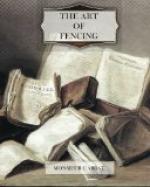Of Feints.
Feints are much used in Fencing, whether it be by reason of their Number, their Ease, or the Success that attends them, gaining more Time and Light than is to be got in plain Thrusts, there being no Thrust to be given so well as after a Feint.
The Number of Feints is so great, by reason of the many Guards and Parades, that I should find it as difficult to describe them, as the Reader would to comprehend them without Experience; so that I shall confine myself to those from which the rest derive, which are, strait Feint, Feint, and double Feint.
By strait feint, is meant a Motion or Feint to Thrust on the Side on which your Sword is, which is to be done on the Inside, the Wrist in Quart, a little higher than the Point which must be near the Adversary’s Sword, that you may be covered, whilst you endeavour to get an Opening. This Motion should be attended with a little Beat of the Right-foot, keeping back the Body. If, at the Time you feint, your Adversary does not stir, you must push Quart: if he parrys with his Feeble, you must immediately disengage to Tierce; and if he parrys high you must cut in Quart under the Wrist.
The Feint, to which I give no other Name, it being the most used, and to distinguish it from the others, is done by feinting from Quart to Tierce, with a little beat of the Foot, keeping the Body back: the Wrist must be raised in Quart, and the Button a little lower than the Pommel, near the Adversary’s Blade; by which means you are covered, and can make your Thrust swifter. If the Adversary does not stir at the Feint, you must go on strait with the Tierce: if he parrys with his Feeble, you must disengage and thrust Quart, and if he parrys with his Fort, you must push Seconde.
Several masters teach to make this Feint from the inside to the outside, with the Wrist turned in Tierce; and indeed they are seemingly in the right; a Feint being a likeness of the beginning of a Thrust; and that likeness cannot be better shown than in the figure of the thrust: but the smart motion of the point, causes the adversary to stir, the figure of the hand no way contributing thereto. You are to consider which is the most proper, not only to make the adversary answer you, but also to make the motion quicker. Monsieur De Latouche says, that from Quart to Quart there is no motion; but we have two instances to the contrary. First, that a Man of experience has his Wrist and the bend of his Arm free, so as to thrust strait in Quart, tho’ in the same figure; and secondly, if there be a motion preceding the Thrust, as in a Disengagement, or a cut under; this motion is sufficient to help the swiftness of the Feint, and of the Thrust: in short, the motion from Quart to Quart, being quicker than feinting from Quart to Tierce, and returning in Quart; it ought to have the preference, swiftness being the line of Fencing. The only Feints that should be made in Tierce, are those that are marked from below above to return below, and from above below to return above.




